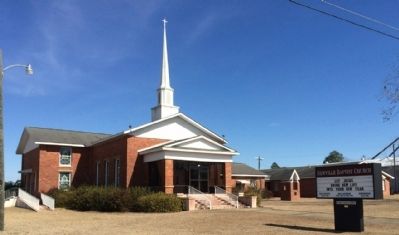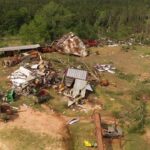
By Roberta Whiddon Childs
In 1876, a group of people began meeting under a brush arbor in this community. I can just see those people in wagons or walking down dirt roads coming to Sunday meeting. They did this for five years.
Tired of the wet and the cold, the little congregation decided to build a church in 1881. It was a crude log building which served as both a church and a school: If the community was to have a school the people had to provide the building and the teacher.
The church was named Center because it was in the center of this farming community. It was close to where the church is today and had a membership of 18. Preaching was held once a month.
In 1890, the Sunday School was organized. The community, known as Wells, was growing and so were the church and the school. On the site of the present church, a two-story structure was built in 1891. The upper story was used as a Grange Hall, a meeting place for a secretive farm society. The Grange was largely responsible for the erection of this building. The first floor was used for worship services and the school. It was modern for its time because it had a ceiling, the first one in the community of Wells to have a ceiling.
On April 10, 1891, William Nathan and Nancy A. G. Roney Kirkland buried their one-year old son William in the churchyard. This is the first known grave in the Cemetery. In July, they buried their three-year old daughter. The graves are directly behind the church sanctuary.
The town of Wells was incorporated as Newville in 1903. There was confusion concerning the mail between Wills in Dale County and Wells in Henry County. J. T. Barnes suggested that the name of the town be changed to Newville, and that is how it was incorporated.
The change in the name of the town was soon followed by a change in the name of the church. With no explanation being recorded, Center Church was referred to as Newville Baptist Church in the 1911 Judson Baptist Association minutes.
My great grandmother, Callie Autman Griffin, who we called Muddie, told me stories about the church when I was little. She said Convention Sings were held at the church quite often. My granddaddy John Wilson Whiddon was totally involved in the sings. He kept the songbooks they used, taking them to the sings and then collecting them and taking them home with him.
Muddie told about how a group of church members bought a pump organ. Some of the other people did not want a musical instrument in the church, so they dragged it out of the church and chopped it up with axes. I don’t know if this part is true, but she said those who chopped up the Organ left and went to Union Springs Baptist Church.
She also said that when people sinned, they would be excommunicated from the church. In the church minutes people would go before the church deacons and confess their bad behavior and ask for forgiveness.
In 1913, the members decided to build a new church. The Grange hall was torn down and the wood was used to build a school building where the school is now. The new church building was made of wood and it was on a brick foundation. The bricks were made from clay taken from a pond near where the vocational school was and the fire station is today. Rev. Smith of Abbeville, formerly of Headland, laid the foundation.
By 1920, the Newville Baptist Church had preaching the first Sunday morning and evening of each month. Sunday School was held every Sunday. Did you know that Newville had a newspaper from 1919 until 1925? It was a great paper, “The Newville Advertiser”. Mr. Green Fuller was the editor and he is buried in the church cemetery. In May of 1920 there was this article on the front page: “The Henry County Singing Convention met at the Newville Baptist Church. Sunday School Superintendent Eddie E. Kirkland dismissed Sunday School and the convention was called to order. People kept coming and coming until there were 2000 people on the grounds. At noon a feast was spread on a 200-foot long table.” Wow, isn’t that something?
The Newville Advertiser had community reporters who did not use their real names, but used nicknames. In March of 1921, Brownie wrote: “The writer attended preaching at the Newville Baptist Church Sunday and Sunday night. Rev. Martin preached an able and interesting sermon. Also attended Sunday School. They have a set of as fine teachers as I ever saw. I always like to go to Newville the people are so clever.” There it is in black and white, if you are from Newville you are clever. If you are not from Newville, well, I am sorry.
There was a meeting of the church members in 1923, and they decided to build a new church. My granddaddy was a contractor among other things and he volunteered to donate his time and services to build the new church. The church was completed in April of 1924. It was the present sanctuary, with balconies on each side and beautiful leaded glass windows. Behind the choir loft was a large room with folding doors that housed two Sunday School classes. On one side was a rest room with indoor plumbing, and there was a baptistery in the floor under where the choir now sits. The cost of the 1923 church building was $7,126.00.
In 1927, with the “Great Depression” looming, the church began stressing over financial problems. They decided the best thing to do was to list all the members names in a book in alphabetical order and post their contributions. The book would be kept in the church and open for inspection at all times. Anyone could see who was contributing to the pastor’s salary and church expenses. They did exactly that, but nowhere in the church minutes does it mention the book again.
Preaching had to be suspended in 1931, until all the money the church owed the preacher was collected and paid. It was not recorded how long they went without preaching services. Times were hard. In 1934, the church had to have a new roof. The church borrowed $526 using the church as security. Two yeas later they still owed $100. It wasn’t until 1937 that they finally collected the last $15 and paid the debt.
At the end of that year they decided to use an “every member canvass system” for financing the church. They appointed a committee and every church member was canvassed and pledged how much they would donate to the church in 1938. They drew up a church budget for $342.50. It worked so well they did it again for 1939. But at the end of 1939, when it was time to do the “every member canvass” again for 1940, most of the members were in the arrears on the 1930 budget. The “every member canvass,” like the book of contributions, disappeared.
Up until 1947, people had used the cemetery for burials whenever they wanted to, and it needed to be enlarged. They drew up a resolution restricting burial in the cemetery. It read: Burial Space would be sold at 25 cents per square foot.
In 1948, they decided that they would build a parsonage, with the idea that they could hire a preacher to serve the Newville Church and the other churches in the community. They collected money for the parsonage and took pledges, but the other churches in the area did not support the idea. The money collected was returned and the pledges were cancelled. Instead of a parsonage they put a new heating system in the church.
In 1950, the deacons recommended that the balconies on each side be closed in and made into four Sunday School rooms. They also recommended that the church buy new pews. The church voted to go half time and have services two Sundays a month. They did not close in the balconies, but did build the Sunday School wing with five classrooms and a rest room at a cost of $1600.00. They also bought new pews, a new piano and put in ceiling fans. Finally in 1953, the members built the parsonage. Bro. Fred Kelley and his family were the first to live in the parsonage.
The church voted to have worship services every Sunday in 1955. That was the year I joined the church and was baptized. The baptistery was a concrete pool under the choir. They moved the wood seats, the kind you saw in movie theaters back then with the seats that folded up. There was removable floor like a lid over the pool. You had to wear white to be baptized. If you were a girl you wore a white dress with a white slip and they pinned it between you legs so it would not float up when you went down the steps. The water was about waist high on the preacher and that water was cold. It was as cold as Jack’s Pool!
The church membership was growing, and by 1956 they needed more Sunday School rooms. The congregation decided to close the balconies and make four Sunday School rooms and build a baptistery, but the project was for some reason postponed.
The next year they again contacted a contractor about the cost of building the baptistery and closing in the balconies, but decided to put a door on the garage of the parsonage and use it for a Sunday School room instead.
Then in 1958, they decided to build an educational building. The building had a pastor’s study, a secretary’s office, ten Sunday School rooms, a kitchen, two restrooms and an assembly room. The next year they remodeled the sanctuary and added a baptistery. They did not need to close in the balconies for Sunday School rooms anymore, so they decided to take them out, but they didn’t. That was the year they had the first Homecoming Day.
In 1971, the church had a problem with termites in the sanctuary and in the educational building. And guess what folks? The termites ate up the balconies and they had to be removed.
After the homecoming services on November 7th of this year, we all went “up town” for the dedication of the Newville Historical Marker. This marker was sponsored by the Henry County Historical Group, Inc., The Historic Chattahoochee Commission, and The Friends of Newville. It was made possible by the generous donations of the members of the Newville Baptist Church and the people who love Newville.
[Roberta Whiddon Childs is a native of Newville, a retired educator, and a member of the Newville Baptist Church. She added the following personal note to her story: I’m Roberta Whiddon and I grew up in Newville. I have two sets of great grandparents and my grandparents buried in the Newville Baptist Church Cemetery. I am descended from the founders of this church and at least 80% of the people buried in the cemetery are my kinfolks. I love Newville and I love the Newville Baptist Church.
If you are at least as young as I am, you remember Mr. Jim Dunn. He became the railroad agent in 1919. He was a long time member and deacon in the church. Let me ask you this, do you have a picture of the Newville Depot? I have asked Mr. Dunn’s family, his grandson, the railroad company, and everyone I see. No one has a picture of the Newville Depot. If you have one, the Henry County Historical Group, Inc., would really like to have a copy of it.]



